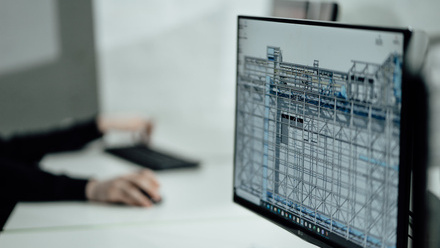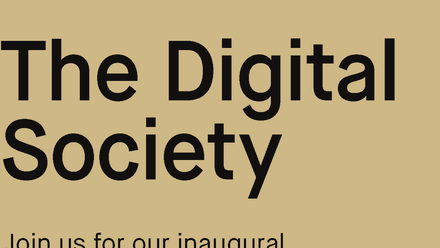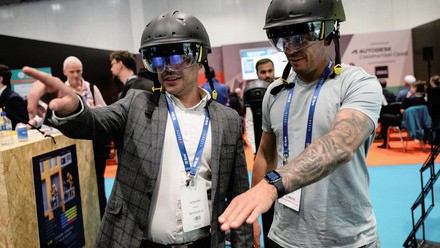Data is a tool for the Architectural Technology professional of the future
New digital tools are transforming the way Architectural Technology professionals work, evolving from analogue 2D plans to digital, networked 3D representations, data anaylsis and AI-supported software applications. These new tools present challenges, but more importantly, they open up a wealth of new opportunities that empower Architectural Technology professionals to design better buildings for a rapidly changing and increasingly complex world.
For example, computer-aided design (CAD) – an industry tool dating back to the 1970s – has allowed for faster and more accurate ways of working, but it is essentially a digital drawing that accurately reproduces what used to be communicated manually: plans, sections, elevations and details.
What happens when this representation is no longer sufficient, when the preferred and most productive tool no longer meets the industry's requirements? The construction industry is currently undergoing this upheaval, which means that many Architectural Technology professionals need to familiarise themselves with new digital tools.
Meeting future challenges through data
The biggest societal challenges we face now and in the coming decades are rapid urbanisation combined with population growth and climate change. The complexity of urban areas has increased massively and meanwhile, climate change is fundamentally affecting the way people live and work in cities.
At the same time, the economic demands on the architectural and construction industry are also increasing. This means the creativity of Architectural Technology professionals are being challenged to maximise building density and use of space without negatively impacting people's quality of life and the environment.
The main digital transformation so far arrived in the shift to BIM (Building Information Modelling) which offers Architectural Technology professionals comprehensive support in this increasingly complex construction landscape. What makes BIM special is the wealth of information that can be accessed quickly and clearly by everyone involved across all stakeholders and disciplines – not only dimensions and quantities, but also costs, deadlines, materials and much more.
Meanwhile, 3D models, digital renderings and, more recently, virtual reality technology provide entirely new perspectives on construction plans and the built environment. Later in the building lifecycle, Digital Twin technology comes into play, where 3D digital models of buildings can be used to plan day-to-day operations based on real-time data. The accuracy, detail and information density of these tools provide the foundation for more efficient collaboration and greater engagement by all stakeholders.
Intelligent insights in early-stage design
Even though BIM has become a natural part of the detailing and construction phases, it has been too cumbersome to be used effectively for early-phase design, leaving Architectural Technology professionals without intelligent tools, for example, for feasibility and concept studies. However, precisely in these stages, it is essential to conduct thorough analyses; after all, this is where the cornerstone of up to 50% of the ultimate value creation is laid. Until now, such measures have been time-consuming and corresponding work approaches counterintuitive for Architectural Technology professionals who typically design first and then analyse, not the other way around.
Thanks to cloud computing and the availability of digital data, this familiar workflow can suddenly be turned on its head: Starting in the early design phase, technology becomes an enabler to supercharge Architectural Technology professionals' intuition and experience. Data is game-changing as it gives Architectural Technology professionals detailed insights so they can make more informed decisions during an entire project starting from feasibility studies to evaluating building performance. Previously selected data was available to Architectural Technology professionals but in manuals, books – now it is all around us and up-to-date: think BIM databases, IoT devices, weather and traffic data, user feedback.
AI, the next evolution in the Architectural Technology professional's toolbox is a tool that excels at completing specialised tasks, thinking along with Architectural Technology professionals to make light work of normally time-consuming, tedious tasks. Data and AI help Architectural Technology professionals move towards a more outcome-based way of working to achieve better end results and enables them to digitally test a wide variety of scenarios and find optimal solutions within the chosen parameters. This risk-free testing environment, integrating design and analysis in one single platform, inspires the discovery of new creative approaches. Designers can test and incorporate factors such as sun, daylight, noise, microclimate in real time right from the start. This lays a solid evidence-based foundation for a more sustainable project and cost-efficient construction phase later down the line.
Expertise of Architectural Technology professionals remain irreplaceable
So what is next for the Architectural Technology professional's toolbox? It is an exciting time: architecture is moving closer to a data-driven, collaborative way of working. As mundane processes become more standardised thanks to technology and more effective workflows, this frees up more time for design.
Only by making data a tool for every designer can we meet the global challenges we currently face.
The one constant in this development is and remains the intuition and expertise of Architectural Technology professionals – they will never be replaced. It is the Architectural Technology professional who has a keen understanding of local specifics and needs - be it cultural and aesthetic values, local and regional building codes, or the complex web of multi-layered relationships that are key to real estate development today and in the future. In the words of renowned architect Sir Norman Foster, "The pencil and computer are, if left to their own devices, equally dumb and only as good as the person driving them."
This article originally appeared in AT Journal issue 144






